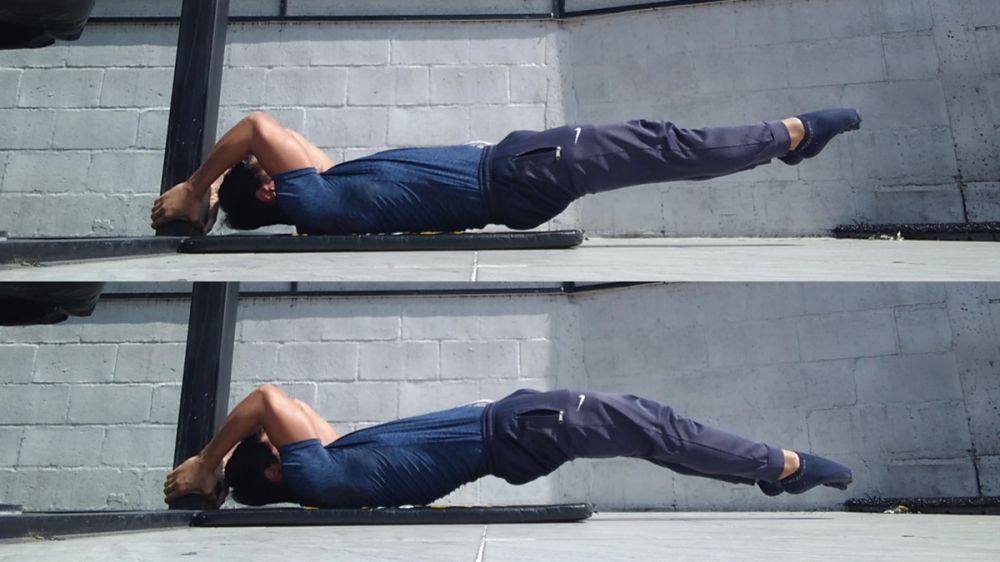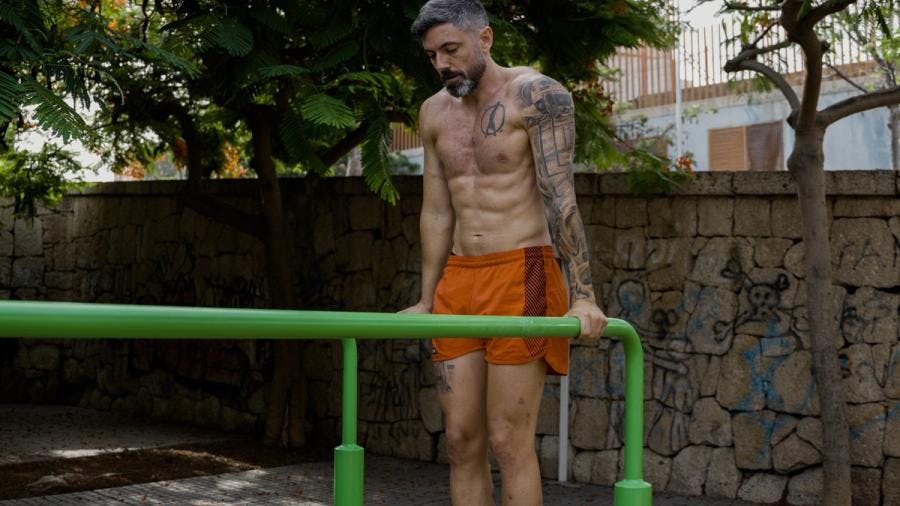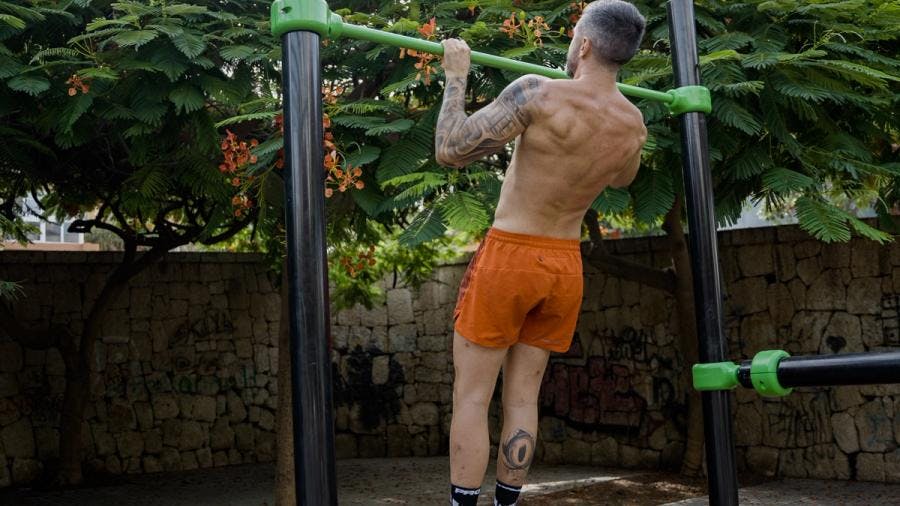
Calisthenic's Dragon Flag: complete guide with exercises
If you want to know everything about how to make dragon flags, here's a complete guide geared towards real progressions.

I recently analized a lot of scientific studies for the article I wrote about how many sets to do per muscle group.
And I found some information that was tremendously shocking to me and that I can't help but share because it reveals things about calisthenics that perhaps are not taken into account today. So let's see what this information tells us, let's get started.
I would like to warn you that we are going to talk about training, but remember that a very important part of gaining muscle mass is diet, which we will cover in other articles.

What I found specifically was a study published by The International Universities Strength and Conditioning Association (IUSCA) that compiles a tremendous amount of papers that specifically deal with muscle hypertrophy and analyzes and summarizes the findings found in them.
Therefore we are talking about quite powerful scientific evidence. Despite there being a large number of studies, they were filtered to eliminate those that were not well designed or rigorous.
Specifically, the part that caught my attention was the loads recommendations, in which it tells us about how much load is optimal for hypertrophy according to different studies, comparing the results of using heavy loads, light loads and intermediate loads.
After analyzing the results of those studies, the conclusion they reach and the recommendation they give is that the best thing for a hypertrophy result is to use intermediate loads, at an intermediate repetition range that classifies between 6 and 20 repetitions, instead of using very heavy loads at low repetitions or very light loads at very high repetitions.
To clarify, they explain that good results can be achieved with all types of loads, but that it is more advantageous to use intermediate loads, since for practical purposes it is more efficient, less exhausting for the nervous system and gentler on the joints.
Let's always remember that this is in the context that with that number of repetitions you reach, or get close, to failure (80 - 90% of your capacity).

This is actually something that most of you would already know, it is something that has been done for hypertrophy for many years, maybe with a more limited range of between 8 and 12 repetitions, but today it is already known that up to 20 repetitions is also perfectly valid.
But, as I said, this is nothing new. What I found revealing and what made me want to write this article is the following question: how do these results relate to calisthenics?
You see, we all know that in calisthenics the basic exercises are push-ups, dips, pull-ups, reaching the point that there are well-known routines that basically consist of these exercises repeated over and over again. How would these exercises be rated in terms of load? That's the key.
For an average person who has some strength but is not an advanced athlete, pull-ups are a medium-load exercise: with 8, 10, 12 or maybe 15 repetitions they reach failure or very close to it. Even push-ups and dips are usually a medium load exercise for a person who has not been training for long.

What conclusion does this lead us to regarding what science says? For a beginner or intermediate person, typical calisthenics routines full of dips, pull-ups and push-ups are optimal for hypertrophy, and that is why such good aesthetic results are usually seen in the first months.
Without knowing it, they are training in the most appropriate way to gain muscle mass while gaining enough strength to continue advancing.
And this leads us to encounter a problem. When that person gains strength, adapts and gains resistance, push-ups immediately become a light load exercise, since they are quickly able to do more than 20 repetitions without too much effort, the dips may take a little longer but also relatively quickly you can do more than 20 without problems.
The ideal would be that from that point on, you would continue advancing but… What happens in practice? That the majority of calisthenics athletes continue to use these exercises non-stop in all their routines, going from the optimal stimulus they had before, to a light load that is no longer effective enough to continue gaining muscle mass.
It is very common to see intermediate and advanced athletes who, when it comes to their basic routine for hypertrophy, continue doing the same simple push-ups and dips that no longer cost them anything, so they would be working with light loads.
In the case of pull-ups it is different because there are very few people who reach the level of being able to do sets of more than 20 repetitions without problem, so the pull-ups do tend to maintain their effectiveness as a muscle growth stimulus.

Perhaps this is one of the reasons why the muscle group that usually stands out the most in calisthenics is the back. Even so, I have seen that many people seem to be afraid of doing sets of more than 10 repetitions of pull-ups, as if there were a law that prohibits it or some type of mental barrier that prevents them from trying to do sets of 12 or 14. or 15 reps.
This also means that it is not an effective exercise to continue gaining muscle mass, in this case not because of the exercise itself, but because we are not getting closer to our true capacity and therefore we are not getting closer to muscle failure.
What I want you to understand is that we have it there, these exercises give us great results when we are starting and then all we have to do is look for more challenging variations to continue within what current science considers optimal for hypertrophy. .
But there is something that we have not mentioned and that I am sure many of you are thinking... The time has come to talk about the legs.
A different situation occurs with the legs, as the typical leg exercises with body weight are very easy almost as soon as you start as a beginner. Therefore, it would be a light load and we would not be doing an effective job.

There are very few people who cannot do 20 bodyweight squats or 20 lunges without problem. Therefore, these exercises would only be valid during the adaptation period of the first weeks or at most the first months. But we would quickly have to look for more difficult variants that allow us to give our legs the intensity they require.
And what usually happens in practice? First, there are many people who do not directly train their legs or do the typical thing of thinking that going for a run from time to time or playing soccer already counts as leg training.
And those who do train them, stay with the typical exercises such as bodyweight squats, lunges, Bulgarians and others and do not advance from there. At most we have the exception of people who do variations of the pistol squat, which can be effective at the appropriate repetition range. But if in a complete leg workout the only difficult exercise you use is the pistol and then the rest of the exercises are the typical simple ones, the training will not be optimal for hypertrophy because only the first exercise was intense enough.
I still think that with Calisthenics you can train your legs well and we are even seeing that in an optimal way according to the latest knowledge. But it is true that you have to know what you are doing and it is not as intuitive as with the upper body. In the article on how many sets to do per muscle group we already saw that the legs require much more volume of work and now in this one we see that we must look for exercises that represent a medium load and not a light load. But if you take these concepts into account, you can train your legs effectively.
If you need examples of specific exercises that are difficult, without being the pistol squat, in Calisteniapp you have the list of exercises in the legs category, where you have a lot of examples of all the difficulties. In addition, you have specific routines, training programs and smart routines for legs that will make sure you give them a good workout. You can also take a look at my article on cadence of movement where I explain how to turn simple exercises into much more challenging exercises.
Also emphasize that scientific results recommend, in addition to focusing on moderate loads, occasionally combining with heavy and light loads, which could give extra results. Therefore, the approach we often take in calisthenics of doing some difficult exercises and strength progressions at the beginning of the routine and adding some easy exercises at the end to finish the routine can be beneficial as well.
Personally, since I started training with a specific hypertrophy goal and doing a bulking diet, I have gained 5 kg. (11 lbs) while maintaining a low fat percentage. During this time my training has been mainly Calisthenics, Weighted Calisthenics and some complementary exercises with gym exercises.

With this article I do not intend to create sides and make this a battle of Calisthenics against gym, or to try to see which is better, in fact we know that there are many people who combine both disciplines and do very well.
But I would like to put a little more value on calisthenics and not underestimate it, since for many people it is a training method that they love and they simply have to learn to apply a couple of concepts to give them great results.
Obviously, each person has their goals, and there are those who are not so interested in hypertrophy but rather what they want is to gain strength, do certain tricks, and so on. But for those who are interested in gaining muscle mass, keep this in mind, review these latest articles that I have published carefully and work hard. It's time for the image of Calisthenics to change.
Finally, let me tell you that this issue of scientific evidence does not have to be categorical, since over time new studies may appear that qualify, modify or discover new aspects that change our perspective. But at the moment it is the most advanced knowledge we have and the smartest thing is to take advantage of it.
There are also obviously specific cases for each person and personal experience must always be taken into account.
That said, I hope you find the article useful.

Yerai Alonso
Cofundador de Calisteniapp, referente en calistenia y el street workout en Español. Con más de una década de experiencia, es creador de uno de los canales de YouTube más influyentes del sector. Autor del libro La calle es tu gimnasio, campeón de Canarias y jurado en competiciones nacionales e internacionales.
Join our newsletter
Learn everything you need to know about calisthenics

If you want to know everything about how to make dragon flags, here's a complete guide geared towards real progressions.

A detailed breakdown of all calisthenics statics. Learn about muscle activation, movement patterns, and precise execution for every isometric skill.

Calisteniapp v25.12.0 introduces program pause, performance improvements, and the 10’ Workout Challenge 2026. No shortcuts, just better tools
